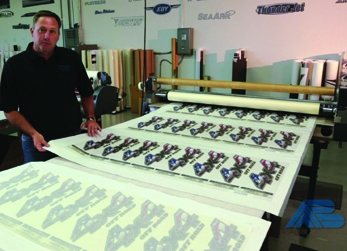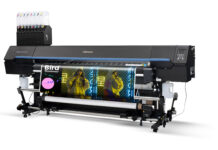When working with vinyl graphics, sometimes it’s more about the pieces of the puzzle than the greater whole. Take ORA Design Group, for instance.
ORA Design (Original Reflective Art) is located in Haysville, Kansas, and the company has found success providing graphics for original equipment manufacturers in the marine, RV, and trailer industries (in addition to individual businesses and retail markets).
The company was established by current owner Jason Laub and now-retired Tony Stoddard five years ago, in an effort to help create one-of-a-kind, effective designs for clients. So when a boat or an RV manufacturer gets ready to premier a new line of vehicles, they’ll approach ORA Design to create the necessary graphic components for them.
The company’s talented roster of designers boasts over seventy years of combined experience, so they know what works and what looks good. “We’ll provide OEM graphics for trailers and standardization letters for boats, for example,” says Laub. “We’ll also provide prototypes identical to production parts.”
Once they’ve finished designing, printing, and laminating the graphics, they’ll ship them back to the client for application to their vehicle(s).
ORA Design builds conceptual artwork of the graphics from scratch to share via PDF with the client.
To create these concepts, the client will provide ORA designers with a profile of their boat, trailer, or RV and (if necessary) give them any style-related guidelines (specific colors, patterns, etc.) to follow. “More times than not, we’ll have to do revisions in order to eventually come up with a finished graphic that suits everyone,” says Laub, lauding the importance of interacting back-and-forth with a client to come up with artwork. “But it’s vital our designers be able to match a company’s style.”
ORA Design works up the concept art in Adobe® Illustrator® and Photoshop®. However they’ve learned that not every manufacturer is able to provide the vector files or bitmap images needed. “So we’ll ask them to send us a brochure or a photo, and we’ll scan that in and work from it,” says Laub. (Note: The conceptualizing process normally takes ORA Design about one to two weeks to complete.)
After final approval, ORA Design prints the approved graphics and/or artwork onto air-egress vinyls using their Mutoh printer and mild solvent-based inks.
Next they utilize their roller laminator to apply either a glossy or matte overlaminate for better graphics protection. Then they set up the patterns onto their Graphtec plotter/printer using Wasatch SoftRIP and cut them out.
Finally they’ll move the rolled graphics to their masking station and load them up on the wide format roll laminator for pre-masking. Pre-masking is an essential component of the production process, as it holds the graphic elements in position and prevents the vinyl from stretching during application.
However before shipping the graphics back to their customers, Laub was noticing tunneling and channeling on them when using conventional pre-mask, since they wouldn’t lay flat on the exposed air-egress liners.
After attending last year’s SGIA Expo last year, Laub came across American Biltrite’s TransferRite® AirMask®, a material specifically developed for partial wraps and cut graphics made with printed or pigmented air-egress vinyls. “It also adheres nicely to a matte overlaminate,” says Laub.
Since it’s a clear base material, Laub notices that he’s also able to see the different colors in the products that they’re printing.
After finishing this “four-step” process (printing, laminating, cutting, and masking), ORA Design rolls the graphics and ships them to their OEM client. If the parts are large, they’ll roll them onto a core. “But for smaller parts, we’ll instead wind them with the graphics facing outwards,” says Laub.
ORA Design usually puts the graphics in a set package—a port and a starboard package for boats, for example. “Sometimes if it’s only a bunch of logos, we’ll just bulk-package everything in one bag,” he says.
They also apply the TransferRite AirMask to domed graphics as well. Laub says the RV and marine industries always have some sort of dome on their vehicles, whether it’s a model designator or a logo.
Laub’s company has found a winning combination involving “high-definition” printing to create domed graphics to make flat decals appear more dimensional. “It’s a little more difficult because it involves another process obviously,” he says, “but we’re able to do the high-resolution printing on different bases and then dome it.
“It makes a nice 3-D appearance.”
View the video to see the process in action.











